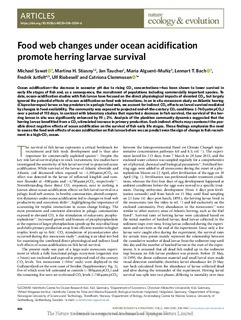| dc.contributor.author | Sswat, Michael | |
| dc.contributor.author | Stiasny, Martina | |
| dc.contributor.author | Taucher, Jan | |
| dc.contributor.author | Alguero-Muñiz, Maria | |
| dc.contributor.author | Bach, Lennart T | |
| dc.contributor.author | Jutfelt, Fredrik | |
| dc.contributor.author | Riebesell, Ulf | |
| dc.contributor.author | Clemmesen, Catriona | |
| dc.date.accessioned | 2019-03-28T09:52:22Z | |
| dc.date.available | 2019-03-28T09:52:22Z | |
| dc.date.created | 2018-03-31T16:12:38Z | |
| dc.date.issued | 2018 | |
| dc.identifier.citation | Nature Ecology and Evolution. 2018, 2 (5), 836-840. | nb_NO |
| dc.identifier.issn | 2397-334X | |
| dc.identifier.uri | http://hdl.handle.net/11250/2592130 | |
| dc.description.abstract | Ocean acidification—the decrease in seawater pH due to rising CO2 concentrations—has been shown to lower survival in early life stages of fish and, as a consequence, the recruitment of populations including commercially important species. To date, ocean-acidification studies with fish larvae have focused on the direct physiological impacts of elevated CO2, but largely ignored the potential effects of ocean acidification on food web interactions. In an in situ mesocosm study on Atlantic herring (Clupea harengus) larvae as top predators in a pelagic food web, we account for indirect CO2 effects on larval survival mediated by changes in food availability. The community was exposed to projected end-of-the-century CO2 conditions (~760 µatm pCO2) over a period of 113 days. In contrast with laboratory studies that reported a decrease in fish survival, the survival of the herring larvae in situ was significantly enhanced by 19 ± 2%. Analysis of the plankton community dynamics suggested that the herring larvae benefitted from a CO2-stimulated increase in primary production. Such indirect effects may counteract the possible direct negative effects of ocean acidification on the survival of fish early life stages. These findings emphasize the need to assess the food web effects of ocean acidification on fish larvae before we can predict even the sign of change in fish recruitment in a high-CO2 ocean. | nb_NO |
| dc.language.iso | eng | nb_NO |
| dc.publisher | Nature Publishing Group | nb_NO |
| dc.title | Food web changes under ocean acidification promote herring larvae survival | nb_NO |
| dc.type | Journal article | nb_NO |
| dc.type | Peer reviewed | nb_NO |
| dc.description.version | acceptedVersion | nb_NO |
| dc.source.pagenumber | 836-840 | nb_NO |
| dc.source.volume | 2 | nb_NO |
| dc.source.journal | Nature Ecology and Evolution | nb_NO |
| dc.source.issue | 5 | nb_NO |
| dc.identifier.doi | 10.1038/s41559-018-0514-6 | |
| dc.identifier.cristin | 1576368 | |
| dc.description.localcode | Copyright © 2018, Springer Nature | nb_NO |
| cristin.unitcode | 194,66,10,0 | |
| cristin.unitname | Institutt for biologi | |
| cristin.ispublished | true | |
| cristin.fulltext | postprint | |
| cristin.qualitycode | 1 | |
